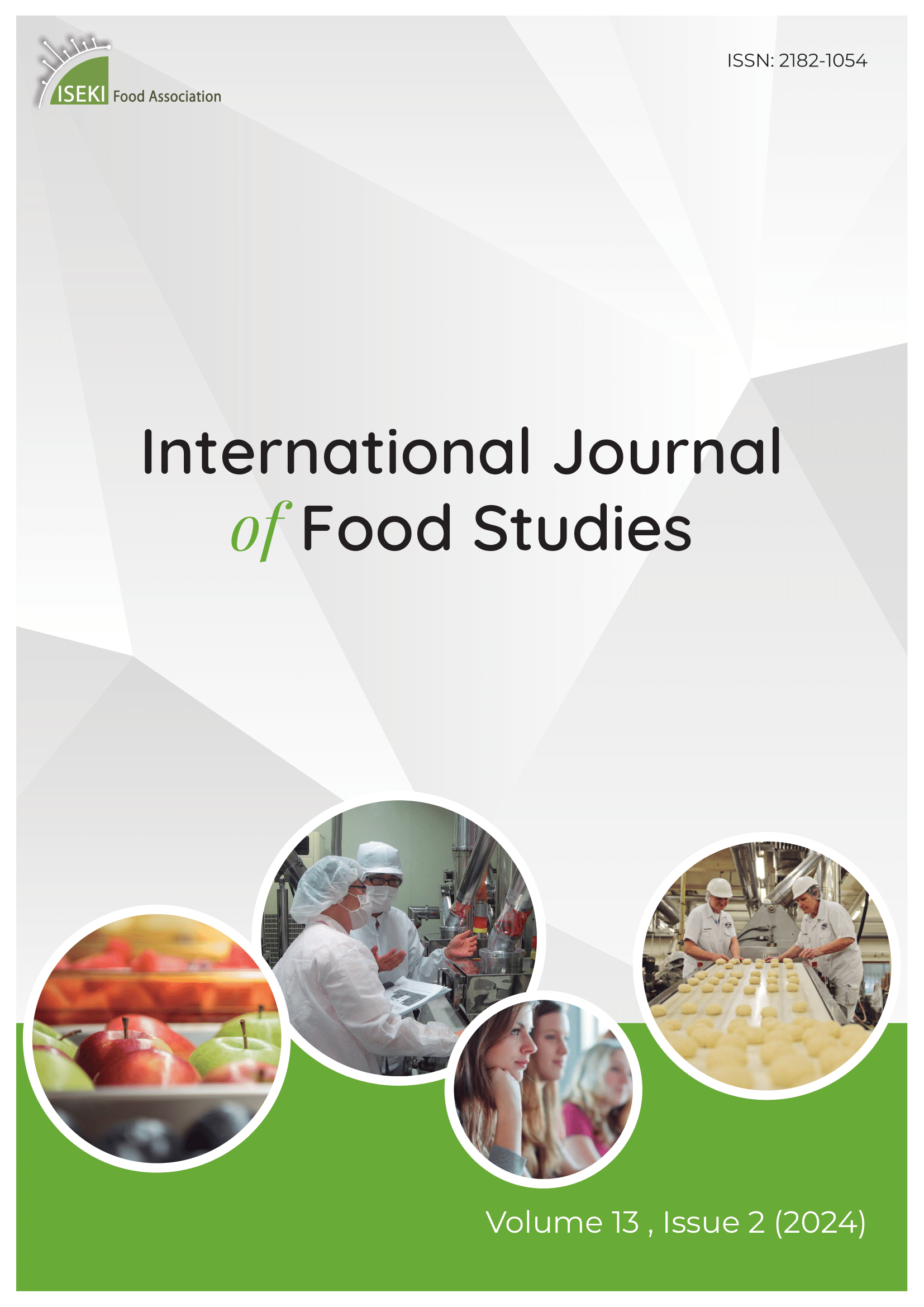Current issue

Volume 13, Issue 2, 2024
Online ISSN: 2182-1054
Volume 13 , Issue 2, (2024)
Published: 18.10.2024.
Open Access
All issues
Contents
18.10.2020.
Original scientific paper
Modelling relationships between raw milk quality parameters and climatic conditions - the case study of a 3-years survey in Serbia
This work examined the relationships between quality characteristics of raw milk and climatic conditions. Over a period of three years, a total of 5,065 samples were collected encompassing two types of farms. The quality characteristics analysed were titratable acidity (TA), total plate count (TPC) and somatic cells count (SCC). Climatic conditions were evaluated in respect to the outdoor air temperature, pressure, humidity and precipitation. Big farms showed a stronger correlation between TA and climatic conditions as opposed to SCC and climatic conditions. TPC was out of limit in big farms when the outdoor air temperature was higher than 19.8 °C (p<0.05) and during periods with accumulated precipitation over 4.2 mm (p>0.05). Small farms showed a stronger correlation between SCC and climatic conditions as opposed to TA. In these farms, occurrence of acidity out of limit was detected in less than 7.2% of samples. Samples with TA out of limit were observed when air temperature was higher than 18.4 °C (p<0.05) and accumulated precipitation was below 3.1 mm (p>0.05). These results can be used to improve good agricultural practices in respect to climatic conditions and size of farms.
Ilija Djekic, Jelena Miočionović, Marija Bojčevski, Nada Šmigić, Igor Tomašević
24.02.2021.
Original scientific paper
Chickpea Protein Isolation, Characterization and Application in Muffin Enrichment
The aim of this study was to enhance the nutritional value and the functional characteristics of muffins by enriching with chickpea protein isolate, while keeping their rheological characteristics. Chickpea Protein isolate (CPI) was prepared by alkaline solubilization (pH 11), followed by isoelectric precipitation at pH 4.5. SDS-PAGE revealed three subunits with molecular weights of 47, 30 and 85 kDa; representing the globulin fractions, legumin-like and vicilin-like proteins. Maximum protein solubility (83.32%) was obtained at pH 11. CPI exhibited an emulsifying activity index of 25.17 m2 g-1, emulsion stability index of 14.09 min. The foaming capacity and stability were 62% and 94.49%, respectively. Water and oil absorption were 3.65 and 2.30 mL g-1, respectively. CPI was added to muffin batter at 0, 2.5, 5, 7.5 and 10%. CPI fortifieded muffins showed reduction in moisture content, which influenced texture profile analysis through increasing hardness, gumminess and chewiness values. Additionally, both protein content and protein digestibility of muffins increased to 22.2 and 94.08%, respectively. CPI-enriched muffins were darker (lower L) with yellowish crumbs (higher b). Finally, preliminary sensory evaluation showed high consumer acceptance for CPI-enriched muffins.
Sobhy Ahmed El Sohaimy, Marageta A. Brennan, Amira Galal Darwish, Charles S. Brennan
24.02.2021.
Original scientific paper
Potential for Development of Novel Food Products from Azanza garckeana Tree Fruit: a Review
Azanza garckeana is among the least utilized indigenous wild fruit trees of interest in the arid and semi-arid regions of Africa. The tree's fruit and seeds have found their importance as food while their barks and leaves as medicine because of their vast nutritional and functional components. This paper reviews the utilization of the fruit in food processing demonstrating the potential this species has in the preparation of novel foods. There are few reports on macronutrients and micronutrient composition of the fruit and the seeds, and their utilization in food processing. Some researchers have identified key functional ingredients in the fruits as well as their seeds that could be of benefit when incorporated in the production of value-added food products. This paper not only advocates for the production of value-added food products from this fruit, but also its integration into farming systems to enhance nutritional security and provide ready income for communities in the dry areas in sub Saharan Africa.
Johnson Kyalo Mwove
18.10.2020.
Original scientific paper
Physicochemical and sensory characteristics of green coconut (Cocos nucifera L.) water kefir
This research aims to examine the effects of fermentation time on the physicochemical and sensory characteristics of green coconut water kefir in order to determine the optimal fermentation time based on the resulting sensory attributes. There were four fermentation time treatments (12, 24, 36, and 48 hours), each with five replications. The materials used were green coconut water and 5% kefir grains. Physical analyses included pH and viscosity, while the chemical analyses included total dissolved solids (TDS), alcohol content, water content, protein content and fat content. Sensory attributes included sourness, soda sensation, sour aroma, viscosity and turbidity. The results showed that fermentation time had significant effects on pH, TDS, alcohol content, water content, protein content and the sensory attributes of green coconut water kefir. Viscosity and fat content were not affected by fermentation time. The ideal fermentation time was 12 hours resulting in a pH level of 4.6, viscosity of 0.09, TDS of 3.8° Brix, alcohol content of 1.16%, water content of 97.14 %, protein content of 6.64 % and fat content of 1.17%. Sensory evaluation found a low level of sourness, low soda sensation, high sour aroma, high viscosity and low turbidity.
Bambang Dwiloka, Heni Rizqiati, Bhakti Etza Setiani
18.10.2020.
Original scientific paper
Estimation of the dietary exposure of polycyclic aromatic hydrocarbons in Syria and their health risks assessment
In this work, the exposure of people, through their diet, to polycyclic aromatic hydrocarbons (PAHs) has been assessed for the urban, rural, and general populations in Syria. The food categories consumed have been divided into major groups, and the health risk assessment on dietary exposure of PAHs determined in each food category. For this purpose, two approaches were used: incremental lifetime cancer risk (ILCR) and margin of exposure approach (MOE). The results showed that each of the following food categories: oils and fats, meat and meat products, vegetables, and cereals dominantly contribute in the dietary exposure of PAHs. Also their MOE values are the lowest. Additionally, they have higher ILCR values. Therefore, these groups are a main risk source to health. On the other hand, the dietary exposure of PAHs in each of urban, rural and general populations was of low health concern, whereas their ILCR values reached to 10E-05 in total food categories, nevertheless it remains lower than serious risk level (ILCR>10E-04). This work is the first study that is dealing with dietary exposure of PAHs and their health risk assessment in Syria.
Hour KRAJIAN
18.10.2020.
Original scientific paper
Quality of postharvest strawberries: comparative effect of fungal chitosan gel, nanoparticles and gel enriched with edible nanoparticles coatings
This study compared, for the first time, the postharvest conservative action of edible fungal chitosan coatings (gel, nanoparticles and gel-nanoparticle) on the physico-chemical, sensorial and microbiological characteristics of strawberries. The nanoparticles were prepared by an ionic gelation method and characterized by dynamic light scattering and scanning electron microscopy. The antioxidant (DPPH* and ABTS*) activity of the edible coatings and the antimicrobial (macrodilution method) action against phytopathogenic fungi were verified. The nanoparticles had a size of 331.1 nm and a zeta potential of+ 34 mV. The gel, nanoparticles and gel+nanoparticles exhibited minimum inhibitory concentration values ranging from 4 to 5, 1.5 to 2.5 and 1.0 + 0.5 to 2.0 + 1.5 g.L-1, respectively. All the edible coatings exhibited antifungal action. All the coatings had high scavenging activity, especially the gel edible coating. The coatings, especially the gel+nanoparticles, decreased the weight loss, microbiological growth, soluble solids, maturity index and moisture loss of the strawberry and preserved the pH values, anthocyanin content, titratable acidity and sensory characteristics. Therefore, the use of chitosan edible coating containing nanoparticles can be a promising strategy to improve the post-harvest quality of strawberries.
Natália Melo, Maria Manuela Estevez Pintado, José Alberto da Costa Medeiros, André Galembeck, Margarida Angélica da Silva Vasconcelos, Viviane Lansky Xavier, Marcos Antônio Barbosa de Lima, Tânia Lucia Montenegro Stamford, Thatiana Montenegro Stamford–Arnaud, Miguel Angel Pelágio Flores, Thayza Christina Montenegro Stamford
18.10.2020.
Original scientific paper
Biodegradable film development by nisin Z addition into hydroxypropylmethylcellulose matrix for mozzarella cheese preservation
Currently, improvement of food preservation has been a substantial challenge for industries to increase shelf-life of products and to maintain food quality during storage. These goals are often tied to the sustainable tendency for use of eco-friendly packaging to store these products without loss of the packaging features. Therefore, the aim of this study was to produce biodegradable antimicrobial films by the incorporation of nisin Z peptide under different concentrations (0 %, 5 %, 10 %, 15 % and 20 % wt.) into hydroxypropylmethylcellulose (HPMC) matrices. The active film properties were evaluated in terms of their antimicrobial capacity in vitro, mechanical performance and microscopic characteristics. Hence, active films containing 10 % (wt.) of nisin Z and control films were placed in contact with sliced mozzarella cheese for eight days, and microbiological growth was monitored during storage. Nisin Z’s antimicrobial effects were observed against the Gram-positive microorganisms such as Staphylococcus aureus and Listeria innocua, regardless if the compound was free as a suspension or incorporated into HPMC matrices. However, the expected low action of nisin Z against Gram-negative bacteria, as reported in literature, was not observed since Salmonella enterica Choleraesuis’s growth was inhibited. Moreover, active films with added nisin Z (10 % wt.) were more effective than the control film to inhibit mesophilic microorganisms in mozzarella cheese during 8 days of storage. The mechanical properties of the films were not influenced by nisin Z incorporation, since the addition of the compound enhanced the active function without the loss of mechanical properties required for a good food packaging. These results suggest that biodegradable films produced by nisin Z addition into HPMC matrix are an excellent biomaterial for mozzarella cheese preservation.
Pedro Augusto de Freitas, Rafael R. A. Silva, Taíla V. de Oliveira, Raquel R. A. Soares, Nilda F. F. Soares
18.10.2020.
Original scientific paper
Research, development and capacity building for food and nutrition security in sub-Saharan Africa
This paper focuses on research, development, and capacity building in relation to food and nutrition security (FNS) in sub-Saharan Africa (SSA). It looks at human capacity, education, teaching and learning, women empowerment, research, innovation and technology, research, indigenous knowledge (IK), institutional aspects, infrastructure, information and communication technologies (ICT), policies and finance. Professional bodies exist in many countries and the extent to which they engage in FNS awareness creation differs. Food and nutrition insecurity continues to affect people in Africa’s 54 nations where the population is expected to double by 2050 with the expected doubling of food production to keep pace with population growth. Within the continent there is a substantial number of human capacity professionals who are global leaders in food, nutrition and related professions. Some research organisations in the continent directly or indirectly benefit from grants administered by developed economies but a challenge exists with brain drain and ageing of qualified and experienced experts. Increasing educational need, coupled with the growing population necessitates attention to ensuring a sustained supply of highly trained, adequately equipped and qualified professionals in the relevant fields of food and nutrition sciences. Higher educational institutions exist in especially those that fall within the 500 in world universities ranking. Research activities take place in the continent along with the translation of research outputs into commercialisable products. Research towards transforming agriculture for improved livelihoods is taking place in different parts of the continent. Education, governance, gender and rural development are the key challenges. Income growth and the impacts of climate change on food production have contributed to food insecurity. ICTs can play an important role for FNS. Strengthening research, development, capacity building and industry cooperation are critical for FNS in Africa.
Afam I. O. Jideani
18.10.2019.
Original scientific paper
Consumer awareness of the use of food labels in Lagos state, Nigeria
The increase in relative level of education and the growing middle-class income earners in Nigeria have made packaged food items attractive to consumers. These foods provide handy, nutritious and convenient food for consumers; however, they also come with public health concerns. From a policy perspective, food labelling can gauge consumers’ response to the safety conditions of packaged food. However, understanding consumers’ awareness and the use of food label information has attracted little research attention in many developing countries in sub-Saharan Africa. In this study, we investigated consumers’ awareness of the use of food safety labels in Lagos state, Nigeria. We used primary data collected using pretested structured questionnaire from 220 food shoppers who bought pre-packaged foods. A two-stage sampling technique was used to select the respondents. Consumers’ awareness and use of food safety information was revealed using descriptive statistics; Ordinal Regression Analysis was used to examine the socioeconomic factors determining the frequency of reading food safety labels. We found evidence of the influence of socioeconomic characteristics on how consumers read food labels. The study therefore recommends that there should be continuous awareness campaigns on the importance of food labels in ensuring safety and food producers should make sure their food labels are legible.
Samuel Danilola, Olubunmi A. Omotesho, Jubril Animashaun
01.12.2018.
Professional paper
Non-fermented synbiotic drink based on lactic cheese whey which incorporates Lactobacillus rhamnosus GG and Lactobacillus paracasei
Sima Taheri, Morteza Khomeiri, Mehran Aalami, Ali Moayedi











